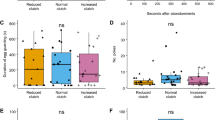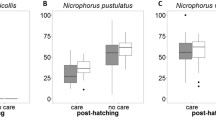Abstract
The expression and maintenance of maternal behavior in the earwig,Euborellia annulipes, was examined through manipulation of clutch size, age, and species and through observations of interactions between brooding females. Females underwent discrete gonadotrophic cycles culminating in oviposition of first clutches that were highly variable in size. Neither the head capsule width nor the age of the mother was correlated with clutch size. Maternal care extended through embryogenesis and for the week following hatching. Clutch removal significantly shortened the interclutch interval, indicating that the presence of brood inhibited the onset of the second gonadotrophic cycle. Brooding females readily accepted replacement clutches of the same age. Thus, mothers did not appear to distinguish their own eggs from those of other females. Experimental doubling of clutch size did not significantly reduce the proportion hatching or fledging. In contrast, reducing clutch size diminished the percentage successfully fledging. Manipulation of clutch age resulted in reduced hatching/fledging success. Placing two females, each with newly laid clutches, in the same cage usually resulted in egg transfer from the nest of one female to that of the other within 12 h. Nests of females with larger forceps were significantly more likely to contain both clutches. When mothers with first clutches were paired with mothers with third clutches, eggs were more likely to be transferred to the nest of the older female.E. annulipes females with newly laid clutches appeared to accept as replacement clutches eggs of the earwigDoru taeniatum. Alien clutches were maintained for the typical duration of embryogenesis; however, noD. taeniatum hatchlings were observed.
Similar content being viewed by others
References
Ammar, E.-D., and Farrag, S. M. (1974). Studies on the behavior and biology of the earwigLabidura riparia Pallas (Derm. Labiduridae).Z. angew. Entomol. 75: 189–196.
Beall, G. (1932). The life history and behavior of the European earwig,Forficula auricularia L. in British Columbia.Proc. Entomol. Soc. Br. Columbia 29: 28–43.
Beier, M. (1959).Klassen und Ordnungen des Tierreichs: Ornung Dermaptera, Geest an Portig, Leipzig, pp. 455–585.
Bennet, C. B. (1904). Earwigs (Anisolabis maritima Bon.).Psyche (Cambr.) 11: 47–53.
Bharadwaj, R. K. (1966). Observations on the bionomics ofEuborellia annulipes (Dermaptera: Labiduridae).Ann. Entomol. Soc. Am. 59: 441–450.
Bhatnagar, R. D. S. (1963). The life-history, growth and transformation in the earwigLabidura riparia (Pallas) (Dermaptera) (Labiduridae).Res. Bull. Panjab Univ. Sci. 14: 225–229.
Caussanel, Cl. (1970). Principales exigences écophysiologiques du forficule des sables,Labidura riparia (Derm. Labiduridae).Ann. Soc. Entomol. Fr. (N.S.) 6: 589–612.
Caussanel, Cl. (1976). Modifications ovariennes au cours des cycles reproducteurs deLabidura riparia Pallas (Insecte, Dermaptère).Bull Soc. Zool. France 101: 575–592.
Charnov, E. L., and Skinner, S. W. (1984). Evolution of host selection and clutch size in parasitoid wasps.Fla. Entomol. 67: 5–21.
Chopard, L. (1949). Dermapères. In Grassé, P. P. (ed.),Traité Zool. 9: 745–770.
Crumb, S. E., Eide, P. E., and Bonn, A. E. (1941).The European earwig.USDA Tech. Bull. 766.
Fulton, B. B. (1924). Some habits of earwigs.Ann. Entomol. Soc. Am. 17: 357–367.
Giles, E. T. (1953). The biology ofAnisolabis littorea (White) (Dermaptera: Labiduridae).Trans. R. Entomol. Soc. N.Z. 80: 383–398.
Godfray, H. C. J., Partridge, L., and Harvey, P. H. (1991). Clutch size.Annu. Rev. Ecol. 22: 409–429.
Guppy, R. (1950). Biology ofAnisolabis maritima (Géné), the seaside earwig, on Vancouver Island (Dermaptera, Labiduridae).Proc. Entomol. Soc. Br. Columb. 46: 14–18.
Gurney, A. B. (1972). Important recent name changes among the earwigs of the genusDoru.USDA Coop. Econ. Insect Rep. 22: 182–185.
Jones, R. W., Gilstrap, F. E., and Andrews, K. L. (1988). Biology and life tables for the predaceous earwig,Doru taeniatum (Derm.: Forficulidae).Entomophaga 33: 43–54.
Knabke, J. J., and Grigarick, A. A. (1971). Biology of the African earwig,Euborellia cincticollis (Gerstaecker) in California and comparative notes onEuborellia annulipes (Lucas).Hilgardia 41: 157–193.
Klemperer, H. G. (1983). Subsocial behaviour inOniticellus cinctus (Coleoptera, Scarabaeidae): effect of the brood on parental care and oviposition.Physiol. Entomol. 8: 393–402.
Klostermeyer, E. C. (1942). The life history and habits of the ring-legged earwig,Euborellia annulipes (Lucas) (Order Dermaptera).J. Kans. Entomol. Soc. 15: 13–18.
Lamb, R. J. (1976). Parental behavior in the Dermaptera with special reference toForficula auricularia (Dermaptera: Forficulidae).Can. Entomol. 108: 609–619.
Linden, M., and Møller, A. P. (1989). Cost of reproduction and covariation of life history traits in birds.Trends Ecol. Evol. 4: 367–371.
Linsenmair, K. E. (1972). Die Bedeutung familienspezifischer “Abzeichen” für den Familienzusammenhalt bei der sozialen WüstenasselHemilepistus reaumuri Audoin & Savigny (Crustacea, Isopoda, Oniscoidea).Z. Tierpsychol. 31: 131–162.
Linsenmair, K. E. (1985). Individual and family recognition in subsocial arthropods, in particular in the desert isopodHemilepistus reaumuri. In Hölldobler, B., and Lindauer, M. (eds.),Fortschritte der Zoologie 31, Experimental Behavioral Ecology and Sociobiology, G. Fischer, Stuttgart, New York, pp. 411–436.
Linsenmair, K. E. (1987). Kin recognition in subsocial arthropods, in particular in the desert isopodHemilepistus reaumuri. In Fletcher, D. J. C., and Michener, C. D. (eds.),Kin Recognition in Animals, Wiley & Sons, Chichester, pp. 121–208.
Linsenmair, K. E. (1989). Sex-specific reproductive patterns in some terrestrial isopods. In Rasa, A. E. O., Vogel, C., and Voland, E. (eds.),Sociobiology of Sexual Reproductive Strategies, Chapman and Hall, London, pp. 19–47.
Neiswander, C. R. (1944). The ring-legged earwig,Euborellia annulipes (Lucas).Bull. Ohio Agr. Exp. Sta. 648: 1–14.
Pesotskaia, E. (1927). Biology of the earwigsForficula tomis andLabidura riparia.Bull. Inst. Sci. Lesshaft. 12: 51–62.
Radl, R. C., and Linsenmair, K. E. (1991). Maternal behaviour and nest recognition in the subsocial earwigLabidura riparia Pallas (Dermaptera: Labiduridae).Ethology 89: 287–296.
Seelinger, G., and Seelinger, U. (1983). On the social organization, alarm and fighting in the primitive cockroachCryptocercus punctulatus Scudder.Z. Tierpsychol. 61: 315–333.
Shepard, M., Waddill, V., and Kloft, W. (1973). Biology of the predaceous earwigLabidura riparia (Dermaptera: Labiduridae).Ann. Entomol. Soc. Am. 66: 837–841.
Tallamy, D. W. (1982). Age specific maternal defense inGargaphia solani (Hemiptera: Tingidae).Behav. Ecol. Sociobiol. 11: 7–11.
Tallamy, D. W. (1985). “Egg dumping” in lace bugs (Gargaphia solani, Hemiptera: Tingidae).Behav. Ecol. Sociobiol. 17: 357–362.
Tallamy, D. W., and Denno, R. F. (1982). Life history trade-offs inGargaphia solani (Hemiptera: Tingidae): The cost of reproduction.Ecology 63: 616–620.
Tourneur, J.-Cl., and Gingras, J. (1992). Egg laying in a northeastern North American (Montréal, Québec) population ofForficula auricularia L. (Dermaptera: Forficulidae).Can. Entomol. 124: 1055–1061.
Vancassel, M. (1973). La fin du cycle parental deLabidura riparia (Dermaptere, Labiduridae).Terre Vie 27: 481–489.
Vancassel, M. (1977). Le développement du cycle parental deLabidura riparia.Biol. Behav. 2: 51–64.
Vancassel, M. (1984). Plasticity and adaptive radiation of dermapteran parental behavior: Results and perspectives.Adv. Study Behav. 14: 51–80.
Vancassel, M., and Foraste, M. (1980). Le comportement parental des Dermaptères.Reprod. Nutr. Dev. 20: 759–770.
Vancassel, M., Foraste, M., Quris, R., Strambi, A., and Strambi, C. (1987). The parental response of femalesLabidura riparia to young and its control.Comp. Endocrinol. (Life Sci. Adv.) 6: 169–173.
Weyrauch, W. K. (1929). Experimentelle Analyse der Brutpflege des OhrwurmesForficula auricularia L.Biol. Centralbl. 49: 543–558.
Author information
Authors and Affiliations
Rights and permissions
About this article
Cite this article
Rankin, S.M., Storm, S.K., Pieto, D.L. et al. Maternal behavior and clutch manipulation in the ring-legged earwig (Dermaptera: Carcinophoridae). J Insect Behav 9, 85–103 (1996). https://doi.org/10.1007/BF02213725
Revised:
Issue Date:
DOI: https://doi.org/10.1007/BF02213725




